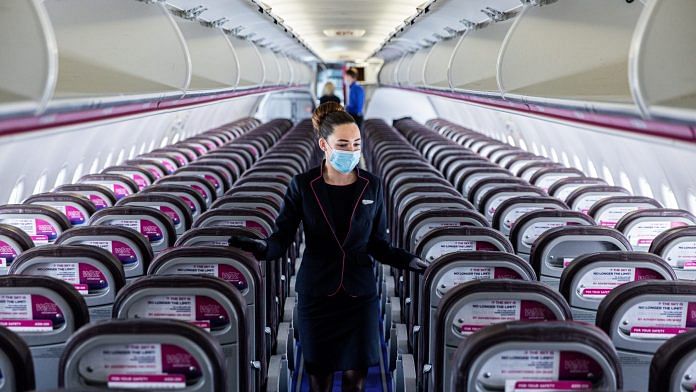Perhaps the most notorious of the many full-airline-cabin photos recently posted on Twitter is one taken by a cardiologist on his return trip to California after helping treat Covid-19 patients in New York City: Passengers wearing a variety of surgical and makeshift masks fill every seat. “I guess @united is relaxing their social distancing policy these days?” the caption asks.
Restaurants, retail stores, gyms and other businesses reopening across the U.S. are subject to state and local rules requiring six feet of space between customers, but airlines are responsible only to themselves. Surely, as Maria Cantwell of Washington, the ranking Democrat on the Senate Commerce Committee, has argued to Transportation Secretary Elaine Chao and the White House Coronavirus Task Force, federal guidelines are needed to make people on long flights as safe from coronavirus infection as people ordering lunch in a pizzeria.
Much about how the coronavirus moves through aircraft cabins remains under study — Boeing and Airbus have investigations in progress — but it’s important to be as careful as possible based on what information exists. If crafted in consultation with engineers, public health experts and the airlines, guidelines could help the industry through the pandemic without a need for new regulations — and, no less important, give air travelers a better idea of what safe conditions look like.
Airlines have every reason to protect public health, of course, at a time when the public has become wary of flying. Since the pandemic hit the U.S. full-force in March, air passenger volume has fallen about 90%, and companies have suspended 60-80% of their flights. Their revenue and stock prices have plummeted. The federal government is spending $50 billion to keep the airlines going — and their employees paid.
Airlines have emailed videos to assure passengers that their planes’ filters remove more than 99% of virus particles from the air; that their crews are doing extra cleaning and sanitizing, even fogging cabins with “high-grade” disinfectant between flights; and that flight attendants and passengers are being required to wear masks. But most companies have been reluctant to guarantee that they will keep middle seats empty or otherwise limit passengers on all flights. (Delta, Spirit and JetBlue are exceptions, pledging to block middle seats at least for a while.) United Airlines, for one, is offering to let fliers on crowded flights rebook. But without guidelines, how can people judge what’s safe?
Airlines should keep sick people from boarding planes, but because the coronavirus can infect people for days before producing symptoms — if it produces them at all — it’s not always possible to identify the contagious.
Open middle seats would help. Although it’s true that modern filters essentially eliminate virus particles from cabin air, those particles circulate, especially in the few rows closest to a contagious person, for three to four minutes before they reach the ventilation system, according to Qingyan Chen, an engineering professor at Purdue University who has studied virus movement aboard aircraft. If two passengers wear cloth masks, they cut their risk of passing the virus between them by three-quarters, Chen says, and if there is at least a seat’s worth of distance between them, the chance of transmission falls by another third.
For the past couple of months, most flights have been empty enough to easily accommodate vacant middle seats. With states reopening and summer ahead, bookings are rising. That’s good news for passengers and airlines alike — but only if, as demand recovers, flights are filled sparsely enough for safety. – Bloomberg
Also read: To fly or not to fly — tips from experts on how to minimize risk






